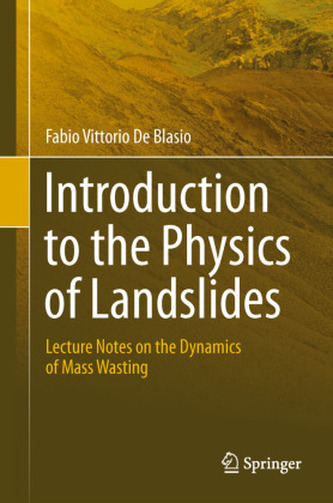Preface.-\n1. Introduction and problems.-\n1.1 Landslides: an overview.-\n1.1.1. What is a landslide?.-\n1.1.2. Landslides as a geological hazard.-\n1.1.3. Landslides as a geomorphic driving force.-\n1.1.4. Physical aspects of landslides.-\n1.2. Types of landslides.-\n1.2.1. Geometrical characteristics of a landslide.-\n1.2.2. Description of the seven types of movements.-\n1.3. A physical classification of Gravity Mass Flows.-\n2. Friction, cohesion, and slope stability.-\n2.1. Friction and Cohesion.-\n2.1.1. Normal and shear stresses.-\n2.1.2. Friction.-\n2.1.3. Cohesion.-\n2.2. Slope Stability\n2.2.1. A few words on slope stability.-\n2.2.2. An example: layered slope.\n2.2.3. A few basics concepts of soil mechanics and an application to slumps.-\n2.2.4. Other factors contributing to instability.-\n3. Introduction to fluid mechanics.-\n3.1. Introduction.-\n3.1.1. What is a fluid?.-\n3.2.Fluid static.-\n3.3. Simple treatment of some topics in fluid dynamics.-\n3.3.1. Fluid flow (key concept: velocity field, streamlines, streamtubes).-\n3.3.2. Fluid flow in a pipe with a constriction (key concepts: continuity, incompressibility).-\n3.3.3. Lift force on a half-cylinder (key concept: energy conservation and the Bernoulli equation).-\n3.3.4. Flow of a plate on a viscous fluid (key concepts: no-slip condition, viscosity, Newtonian fluids).-\n3.3.5. Fluid pattern around a cylinder (key concepts: Reynolds number, turbulence).-\n3.4. Microscopic model of a fluid and mass conservation.-\n3.4.1. The pressure in a gas is due to the impact of molecules.-\n3.4.2. Viscosity.-\n3.5. Conservation of mass: the continuity equation.-\n3.5.1. Flux.-\n3.5.2. Continuity equation in Cartesian coordinates.-\n3.6. A more rigorous approach to Fluid Mechanics: momentum and Navier-Stokes equation.-\n3.6.1. Lagrangian and Eulerian viewpoints.-\n3.6.2. Momentum equation.-\n3.6.3. Analysis of the forces.-\n3.6.4. Adding up the rheological properties: the Navier-Stokes equation.-\n3.7. Some applications.-\n3.7.1. Dimensionless numbers in fluid dynamics.-\n3.7.2. Application to open flow of infinite width channel.-\n4. Non-Newtonian fluids, mudflows, and debris flows: a rheological approach.-\n4.1. Momentum equations, rheology, and fluid flow.-\n4.2. Dirty water: the rheology of dilute suspensions.-\n4.3. Very dirty water: rheology of clay slurries and muds.-\n4.3.1. Clay mixtures.-\n4.3.2. Interaction between clay particles.-\n4.3.2. Rheology of clay mixtures and other fluids.-\n4.3.4. Bingham and Herschel Bulkley.-\n4.3.5. Shear strength as a function of the solid concentration.-\n4.3.6. Relationship between soil properties and fluid dynamics properties.-\n4.4. Behavior of a mudflow described by Bingham rheology: one-dimensional system.-\n4.5. Flow of a Bingham fluid in a channel.-\n4.6. Rheological flows: general properties.-\n4.6.1. Introduction.-\n4.6.2. Geological Materials of rheological flows.-\n4.6.3. Structure of a debris flow chute and deposit.-\n4.6.4. Examples of rheological flows.-\n4.7. Debris flows: dynamics.-\n4.7.1. Velocity.-\n4.7.2. Dynamical description of a debris flow.-\n4.7.3. Impact force of a debris flow against a barrier.-\n4.7.4. Quasi-periodicity.-\n4.7.5. Theoretical and semiempirical formulas to predict the velocity.-\n5. A short introduction to the physics of granular media.-\n5.1 Introduction to granular materials.-\n5.1.1. Solid mechanics: Hooke\'s law, Poisson coefficients, elasticity.-\n5.1.2. Granular media in the Earth Sciences. Angle of repose.-\n5.1.3. Force between grains.-\n5.2. Static of granular materials.-\n5.2.1. Pressures inside a container filled with granular material.-\n5.2.2. Force chains.-\n5.3. Grain Collisions.-\n5.3.1. Grain-wall collisions.-\n5.3.2. Grain-grain collisions.-\n5.4. Dynamics of granular materials; avalanching.-\n5.4.1. General.-\n5.4.2. Dynamics of granular materials at high shear rate: granular gases and granular temperature.-\n5.4.3. Haff\'s equation.-\n5.4.4. Fluid dynamical model of a gra
\n ukryj opis- Wydawnictwo: Springer Netherlands
- Kod:
- Rok wydania: 2014
- Język: Angielski
- Oprawa: Miękka
- Liczba stron: 408
- Szerokość opakowania: 15.5 cm
- Wysokość opakowania: 23.5 cm


 Kontakt
Kontakt
 Konto
Konto
















Recenzja